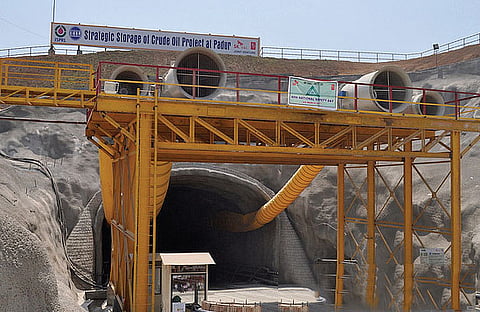

NEW DELHI: Bureaucratic lethargy, slow decision-making and poor execution have led India to miss a huge opportunity to buy and store crude oil at a time when it is trading at its life-time low of $49.80 a barrel. It cannot do so because none of the three proposed caverns (underground crude oil storage facilities) or strategic reserves that it plans to build at Visakhapatnam (in Andhra Pradesh), Mangaluru (Karnataka) and Padur (Kerala) is anywhere near completion.
Construction of the facility at Visakhapatnam (storage capacity of 1.33 million metric tonnes) started in 2008 and was to be completed in October 2012. The first cavern, which was expected to be commissioned in January 2015, will now be ready only by February 2015, depriving India the cost advantage of buying crude oil at a dirt cheap price.
Even if the Visakhapatnam cavern had been commissioned, India would have been able to buy and fill it at an estimated cost of Rs 42,000 crore, at current crude price of $49.50 per barrel. But, by the time the caverns are ready, crude oil prices are likely to go up and India will need to spend far more in foreign exchange to buy the same amount of crude oil.
The Indian Strategic Petroleum Reserves Limited (ISPRL), a Special Purpose Vehicle owned by the government -owned Oil Industry Development Board (OIDB), claims on its website that only 1 per cent construction work is pending at the Visakhapatnam cavern and the facility will be functional in February 2015. Sources say work at Visakhapatnam cavern suffered a major setback in 2010 as a portion of the under-construction tunnel caved in, killing one and delaying work by at least two years. The accident, sources say, happened because ISPRL was in a hurry to show the pace of progress being made at the Visakhapatnam site.
Owing to this delay, the cost of the project has now gone up by Rs 140 crore from its original estimated cost of Rs 1,038 crore, when the cavern was commissioned in 2008. According to sources, the Visakhapatnam project is being delayed further given the glitches in pipeline work, like cost escalation, unused critical components and tardy completion deadlines. There is a lack of clarity on who will fund the buying of the enormous amount of crude oil that will be required to fill up the caverns.
Construction at the Mangaluru cavern, with a capacity of 1.5 MMT, was started in April 2009 at an estimated cost of Rs 1,227 crore, but even here, work is way behind schedule. Orders for laying 48 km of pipeline to carry crude oil to the cavern were placed only in June 2014, when they should have been placed four years ago.
The Mangaluru cavern is scheduled for completion in 2015, when crude prices are expected to trade at $57 to $70. This will again deprive India the cost advantage of buying crude oil at low rates. Similarly, the cavern in Padur, which is expected to be the largest of the three, with a capacity of 2.50 MMT and likely to be constructed at an estimated cost of Rs 1,639 crore, is also running behind schedule. At the site, 36 km of pipeline is to be laid, but work is being delayed due to inclement weather. Construction at the Padur cavern was started in May 2010 and is expected to be completed this year, once again depriving India a chance to fill up its caverns with crude oil at a low cost.
Despite all the delays and cost escalation, the government is planning a second phase. It plans to create 12.5 million tonnes’ storage capacity for crude oil at Padur, Chandikhol (Odisha), Bikaner (Rajasthan) and Rajkot (Gujarat). Chandikhol is likely to be underground concrete tanks.